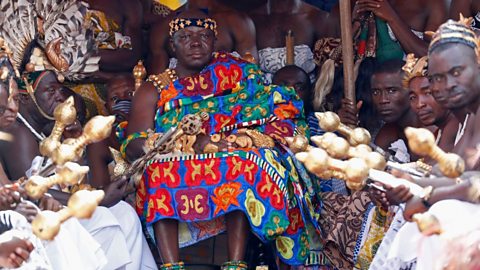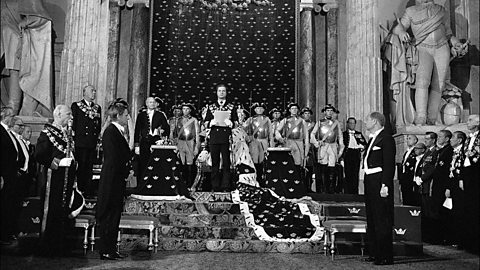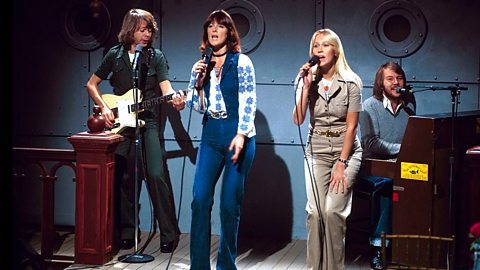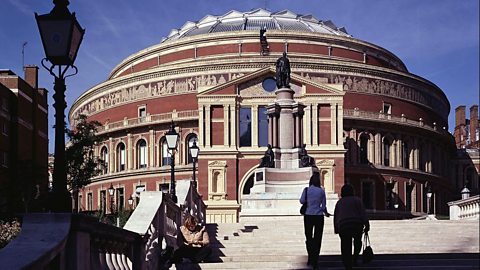2023 sees the coronation of King Charles III, and also marks 70 years since the late Queen Elizabeth II was crowned in Westminster Abbey. Many people who were around on that day in 1953 can still remember the events clearly.
As far as coronation ceremonies are concerned, the UK is almost unique in Europe. In other countries, such as Spain and the Netherlands, the event is normally more low-key. However, there are parts of the world in which coronations happen on a large scale. В鶹№ЩНшКЧТіИлїЪ Bitesize has taken a look at a small, yet regal, selection of ceremonies - from the relatively discreet, to those observed by crowds of thousands.
The Asantehene of Ashanti and the Golden Stool
The Ashanti region of Ghana in West Africa is ruled over by the Asanthene, whose palace is based in Kumasi, the capital of the Ashanti kingdom.

The most sacred object in Ashanti culture is the Golden Stool, known as the Sika Dwa Kofi, and it plays a key role in a coronation. Whenever a new Asantehene is crowned, he is raised and lowered over the stool, without touching it. It is brought to the Asantehene on a pillow as part of the ceremony. As it is also the royal throne, it is placed on a blanket while in use as it should never make contact with the ground.
The Golden Stool is so significant in Ashanti culture, it features prominently on the flag. The current Asantehene is Otumfuo Osei Tutu II, who was crowned in 1999.
Sweden’s straightforward investiture
There is nothing to stop the Swedish monarchy having a full-blown coronation to welcome a new head of state, but an official crowning hasn’t happened since Oscar II took the throne in 1873.

Carl XVI Gustaf, the current king, has reigned since September 1973. Instead of a coronation, he took what is called the regal assurance, which was a requirement to become king, at a meeting of the Swedish cabinet. A ceremony then took place at the Royal Palace in Stockholm where the crown jewels were on display either side of the throne, but not worn. The new king then made a speech to acknowledge his accession, before greeting well-wishers from a balcony.
Although it may not sound as elaborate and glitzy as the crowning of Queen Elizabeth II, Carl XVI Gustaf’s reign can boast a great showbiz moment. In 1976, he married Silvia Sommerlath, whom he met at the 1972 Munich Olympics where she worked as an interpreter. In a TV special screened the night before the ceremony, the Swedish group ABBA gave one of the very first performances of their future hit Dancing Queen, in recognition of their future queen.
A headband with feathers in Lesotho
The African kingdom of Lesotho gained independence from the UK in 1966. Prior to this it was known as Basutoland and had monarchs dating back to Moshoeshoe I in 1822.
Since 1966, Lesotho has had four kings. The reigning monarch is Letsie III and his title reflects the fact that there were two other kings with the same name when the kingdom was known as Basutoland.

Letsie III’s crowning took place in a sports stadium in the capital city Maseru, and was attended by the then Prince Charles from the UK Royal Family and Nelson Mandela, who was president of South Africa at the time. The event saw the new monarch arrive under escort of mounted police who were decked out in red uniforms while carrying ceremonial weapons.
The new king wore traditional animal skins; beneath them was a blue tunic with a gold crocodile embroidered on it. The crowning itself was carried out by two chieftains. They placed a beaded headband containing brown and white feathers on their new king’s head before the ceremony continued to the sights and sounds of traditional dancing and songs.
Thailand’s three-day ceremony
There are many rituals involved in a Thai coronation, with one happening as recently as May 2019, when Maha Vajiralongkorn took to the throne.
The ceremony involved elements of Buddhist and Brahman rites. One of these is the handing over of an umbrella which has nine tiers and signifies the authority of the new ruler.

In the weeks leading up to the 2019 coronation, water was collected from more than 100 sources across Thailand between the time of 11:52 and 12:38, considered a significant time in Thai astrology. Water plays a big part in Thai culture, with all the amounts collected blessed in Buddhist ceremonies. It was then used for the new King to bathe, and also to To make someone a king or queen, usually as part of a religious ceremony, which can involve, for example, rubbing oil or holy water on them. him as he sat on an octagonal throne made from fig wood.
The coronation process can take a few days to complete. In 2019, it ran from 4 to 6 May and ended with the new King addressing the public from his balcony at the palace and also taking part in processions around the capital city, Bangkok.
This article was published in May 2022 and last updated in April 2023
'The world was watching and I was there'
People who played a part in the Coronation, Live Aid and London 2012

The most educational Abba quiz in the world - ever
How the Swedish group can teach us about Maths, Geography, History and Modern Foreign Languages

The remarkable first 150 years of the Royal Albert Hall
A venue that's welcomed pop stars, classical musicians and the world's first sci-fi convention
